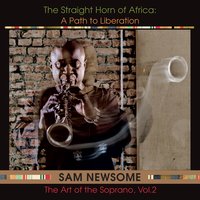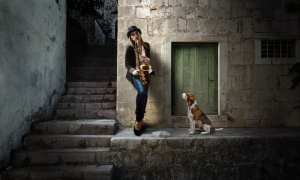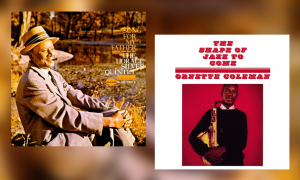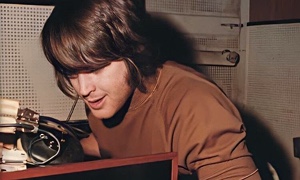Home » Jazz Articles » Building a Jazz Library » Solo Recordings for Non-Traditionalists
Solo Recordings for Non-Traditionalists

Courtesy Harald Krichel
I can see forms and shapes in my mind when I solo, just as a painter can see forms and shapes when he starts painting.
—Elvin Jones
The late guitarist Derek Bailey described the solo performance as the progression in developing the artist's individual language. The unique vernacular of artists such as Thelonious Monk, Django Reinhardt, Wadada Leo Smith, Jaco Pastorius or Matthew Shipp, is best appreciated when they step away from their colleagues. When everything extraneous is removed, when there are no signals to acknowledge, the narrative can only be deeply personal, the music distinctly theirs.
Piano/keyboards and guitar solo recordings demand their own jazz library sections. The chordal instrument families lend themselves to unaccompanied performance, and the variety of styles is almost limitless. Nevertheless, a couple of hollow-body entries are included here because of their historical significance or their singularity.
 David Mott
David Mott Dragonhorn
Self Produced
2011
With Dragonhorn, baritone saxophonist David Mott turned out the finest solo sax recording since Anthony Braxton's Wesleyan (12 Altosolos) (Hat Hut Records 1992). That is not to suggest that Mott's work is similar to Braxton's particular style. His ten compositions are not given to episodic jumps, vibrations, or anything remotely antiseptic. Rather, they are packed with emotion, atmosphere, and rich, full sound. The variety of this collection and Mott's compositional talents are imposing, but his playing impresses above all else. From his native Canada's natural sounds on "Spirit of the Woods" to his classically influenced "Wordless," Mott has created a small masterpiece of innovation.
 Susana Santos Silva
Susana Santos Silva All the Rivers—Live at Panteão Nacional
Clean Feed Records
2018
Portuguese trumpeter Susana Santos Silva is at home in the colloquial language of traditional jazz and the avant-garde. Still, her strength is in a sound that is more idiosyncratic and undefinable. All the Rivers consists of a single continuous title track; Santos plays not only the trumpet but also the physical structure of the venue. The improvised piece was recorded at the Santa Engrácia's Church in Lisbon, and the echo and natural acoustic properties of the church become a proxy for something comparable to electronic augmentation. But Santos alone directs the sound into the nooks and crannies of Santa Engrácia, modulates and changes the harmonics and toys with the trumpet's dynamics and timbre. It's a beautiful album that should please fans of the avant-garde and open the more traditional listener's ears.
 Eberhard Weber
Eberhard Weber Pendulum
ECM Records
1993
The German bassist, whose characteristic style helped shape the "ECM sound," suffered a stroke in 2007, leaving him unable to play. He preferred to play in larger ensemble company, but on Pendulum, his only solo recording, he is accompanied only by an echo unit and some overdubbing. As a composer, his distinctive amalgamation of classical elements, minimalism, and chamber jazz are all reflected across these nine original pieces. Pendulum is one of the best ECM releases of the 1990s.
 Anthony Braxton
Anthony Braxton For Alto
Delmark
1969
Except for Cecil Taylor, no artist draws more combined admiration and ire than composer/multi-instrumentalist Anthony Braxton. When he recorded For Alto it was the first full-length solo saxophone album. More than fifty years later, these free jazz creations have not mellowed with time. The track "To Pianist Cecil Taylor" is both quaint in its title and prescient in its categorization of the two improvisers. For Alto is not without melodies: "Dedicated to Multi-Instrumentalist Jack Gell" is a brief illustration, but the bulk of the music is intense atonalism.
 Abdul Moimême
Abdul Moimême Exosphere
Creative Sources Recordings
2017
Exosphere is a solo guitar album that isn't. It features Abdul Moimême on his two home-made electric guitars, enhancers, and various sound devices. The sole track is the forty-one-minute title piece. Much of what Moimême does here is a product of reverberation, and what he does with that reverberation is remarkable. Listen at the sixteen-minute mark in, and you'll hear something akin to a muted blast of trumpets. Further in, there is the jangle of chimes and later still the approximation of piano keys. All these peripheral effects lie within a broader universe that is indeterminate in nature. Rarely does Moimême incorporate a guitar-like dynamic—he plays his two custom guitars simultaneously using an electronic bow, amplified through a pre-amp and two speakers. He utilizes a gyroscope, music boxes, and other objects to create an otherworldly soundscape. There is some intangible quality to Moimême's composition that makes one want to listen repeatedly.
 Susie Ibarra
Susie Ibarra Drum Sketches
Innova
2010
Solo percussion recordings rarely generate a queue on release—in large part due to the absence of melody and the almost ubiquitous presence of discordant beating, white noise, and/or industrial clatter. It is not that the less traditional sounds don't create a narrative, but that the narrative is not very compelling throughout an entire collection. An exception is Susie Ibarra's Drum Sketches. Ibarra is equally at home with traditional drumming, Asian gong music, conventional techniques, and very unusual ones. On Drum Sketches, her sound's dimensions are vertical, giving the relationship of various tones a strong sense of harmony rather than the more typical accents.
 Jonah Parzen-Johnson
Jonah Parzen-Johnson I Try To Remember Where I Come From
Clean Feed Records
2017
A creator of experimental music in a different vein, Parzen-Johnson released two previous solo efforts, each utilizing the baritone saxophone and synthesizer, recorded live and without overdubs. Those earlier albums display Parzen-Johnson's skill at telling stories through his instruments' voices and making the foot pedal technicalities of the synthesizer/saxophone connection a non-intrusive conduit.
 Nate Wooley
Nate Wooley The Almond
Pogus
2012
It takes some endurance to get to the half-way point of this seventy-minute, single-track album. At that marker, The Almond begins to slightly accelerate its forward momentum. Wooley's overdubbed trumpet relies on only a few sustained notes, carried out drone-like but consisting of iterations of pitch, a variety of recording locations, various mutes, mics, and tonal alterations. When listening, as Wooley suggests, loudly through headphones, phrases, layers and tempos become more evident. The Almond is sumptuous and strangely exhilarating.
 Sam Newsome
Sam Newsome The Straight Horn of Africa: A Path to Liberation
Self Produced
2014
To suit the objectives of The Straight Horn of Africa Newsome's use of technical layering has been protracted to include multi-phonics that create the impression of a larger group. However, the twenty-one relatively short tracks are not meant to be an exercise in the soprano capabilities—the straight horn—but an auditory conduit to Africa, meeting Newsome's ambitious goal to evoke the soul and vitality of the continent. As a sociological experiment, the album humanizes Africa's many diverse musical influences by incorporating them into avant-garde treatments that give them a larger platform in the world. Newsome is tireless in pursuing new and open views of music, his instrument, and the bigger picture.
 Andrew Hill
Andrew Hill Solos: The Jazz Sessions
Original Spin Music
2013
Hill's Solos: The Jazz Sessions is the one piano album included here for several reasons. Released six years after his passing, the album doesn't show up in most online discographies or even on the artist's Wikipedia page, though it is widely available for purchase. Despite his accomplishments, particularly with Blue Note Records, Hill spent most of his career without achieving the wide public recognition he enjoyed inside jazz.
His avant-garde contemporaries like Cecil Taylor and Anthony Braxton often pushed the boundaries of their music in directly experimental and mathematical ways, but Hill's unique ability was to embrace melody even as he took it to the breaking point. His capacity to cast it off and reel it back in seamlessly was a gift. In Hill's unique creative process, he danced his way inside and outside harmonies, and despite comparisons to Thelonious Monk his approach to composition was mostly uninfluenced by others. This recording belongs in any collection because it dramatically moves borders without ignoring the past and is truly unlike anything that fits neatly into a category. Hill's Solos: The Jazz Sessions has left us with a fitting and beautiful eulogy, free of ego and full of creative energy.
Tags
PREVIOUS / NEXT
Support All About Jazz
 All About Jazz has been a pillar of jazz since 1995, championing it as an art form and, more importantly, supporting the musicians who make it. Our enduring commitment has made "AAJ" one of the most culturally important websites of its kind, read by hundreds of thousands of fans, musicians and industry figures every month.
All About Jazz has been a pillar of jazz since 1995, championing it as an art form and, more importantly, supporting the musicians who make it. Our enduring commitment has made "AAJ" one of the most culturally important websites of its kind, read by hundreds of thousands of fans, musicians and industry figures every month.





















